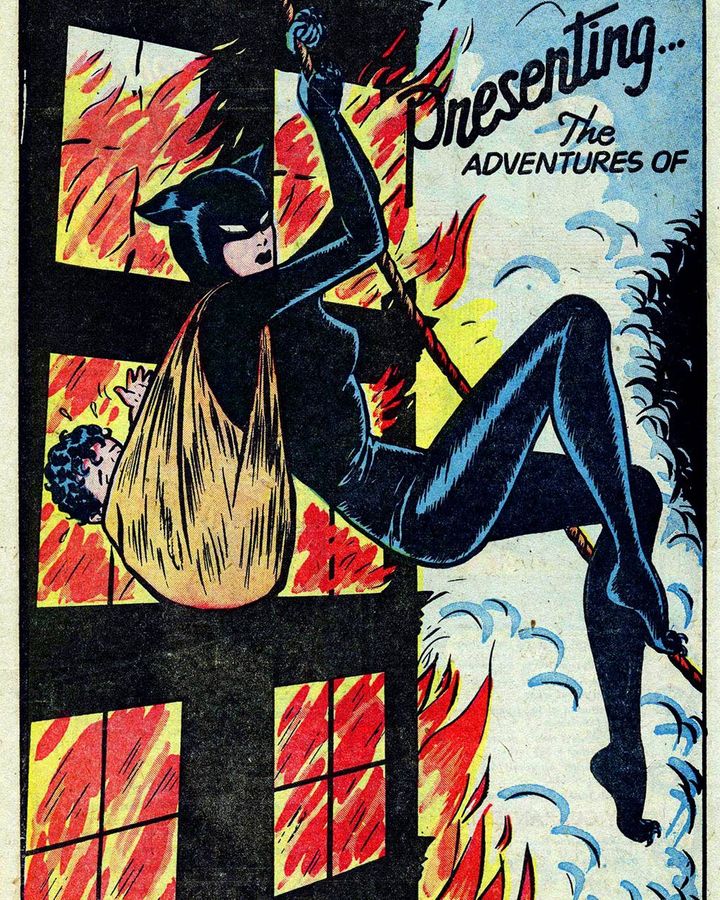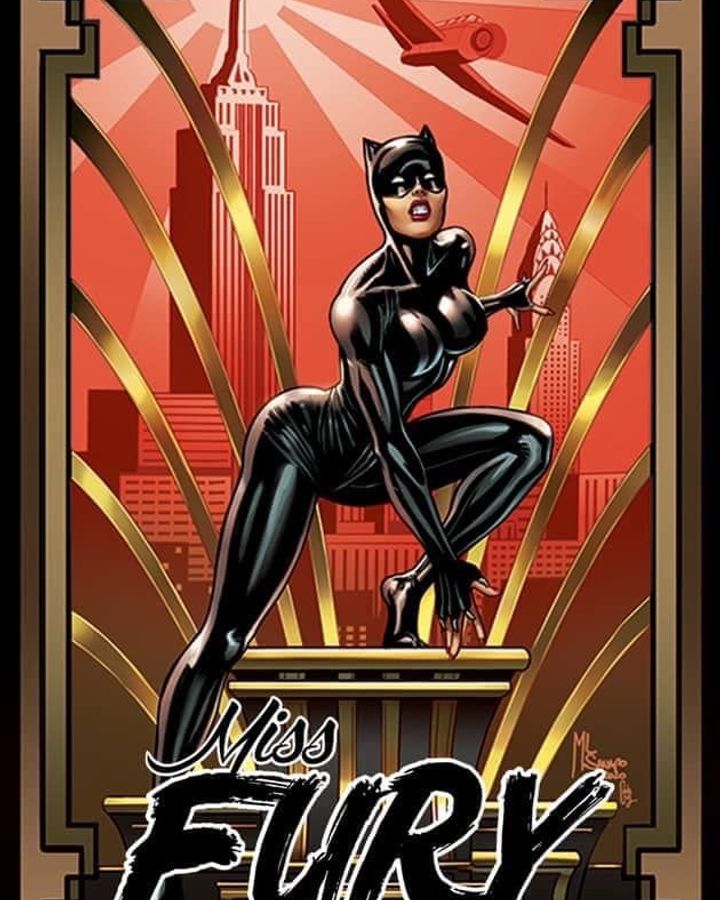This autumn sees the 80th anniversary of Wonder Woman, who made her comics debut in October 1941, two years after Batman and three years after Superman. But before we start celebrating, we should raise a glass to another, even more groundbreaking superheroine who swung into action six months earlier, in April 1941. Her name was Miss Fury. Written and drawn by June Tarpé Mills, she was the first superheroine to be created by a woman, which is one of many reasons why she is still so inspirational, eight decades on. Her devotees include Maria Laura Sanapo, an Italian comics artist. "I think that the birth of Miss Fury can be considered the beginning of a new era," Sanapo tells BBC Culture.
More like this:
– The ancient roots of Wonder Woman
– Do we still need superheroes?
– The moment comic books grew up
Mills was born in Brooklyn, New York either in 1912 or 1918, according to different sources. Raised by her widowed mother and their relatives, she worked as a model and a fashion illustrator before selling her first comic strips in the late 1930s, featuring the escapades of such two-fisted swashbucklers as The Purple Zombie, Mann of India, and Daredevil Barry Finn (not to mention his amphibious sidekick, Frogga). But when Mills signed those strips, she dropped the "June" in favour of her androgynous middle name (her mother's maiden name), so that she would be known as Tarpé Mills. "It would have been a major letdown to the kids if they found out that the author of such virile and awesome characters was a gal," she told the New York Post – a sentiment which would be echoed by Joanne Rowling nearly 60 years later when choosing the pen name JK.

Miss Fury wore a slinky jumpsuit, complete with cat-eared mask, to fight crime a quarter of century before Catwoman came on the scene (Credit: June Tarpé Mills)
However Mills's true identity didn't stay hidden for long. Her big break was a weekly Sunday newspaper strip about someone who was just as awesome as Daredevil Barry Finn – but who, the publicity materials emphasised, borrowed her indomitable personality and her glamorous, raven-haired looks from Mills herself. The first Miss Fury strips (or rather, Black Fury strips, until Mills changed the title shortly afterwards) are a sort of distaff pastiche of Batman. They introduce Marla Drake, a New York socialite who is about to go to a fancy-dress party in a frilly red Scarlett O’Hara gown when a friend phones to say that someone else has picked the same outfit. Over-reacting slightly, Marla shreds the dress with her bare hands, thus affording readers a glimpse of her stockings and suspenders, but her understandably perturbed French maid Francine has a suggestion: "Why not wear the black leopard skin your uncle left you?" Presumably, Mills was getting panthers and leopards mixed up. She also falls back on the exoticising clichés of the time and establishes that the skin was a ceremonial robe worn by an African witch doctor. But it just so happens to be a slinky jumpsuit, complete with cat-eared mask, claws and tail. This, don't forget, was a quarter of a century before Catwoman and Black Panther began wearing almost identical costumes – and in French, incidentally, the character was called La Panthère Noire.
Marla learns that the skin-tight ceremonial robe is "endowed with strange powers which enabled its wearer to accomplish whatever mission he or she set out upon". All of a sudden, she is outsmarting and outfighting tough guys in suits and trilbies, and her crime-busting exploits are hitting the gossip columns: "This black-clad venus must be a veritable feline fury!" But a strip that promises to be a hardboiled New York-gangster serial gets more outlandish and outrageous at breathtaking speed. Within a few weeks, Marla is entangled in the blackmail schemes of the gold-digging Baroness Erica Von Kampf, whose triangular fringe hides a swastika that has been branded on her forehead. Within a few more, Marla is teaming up with an albino Brazilian tribesman, and defeating the army of General Bruno, a monocled Nazi who lost an arm in an explosion after he taped a bomb to Marla's pet cat. "It really felt as though anything could happen," says Mike Madrid, the author of The Supergirls: Fashion, Feminism, Fantasy, and the History of Comic Book Heroines. "Comics were usually aimed either at boys or girls in the 1940s, but Mills mashed up genres to make a unique hybrid of superhero, romance, adventure, western and war comic."
A very modern action woman
Miss Fury herself was unique, too. "She doesn't have a lot of physical strength, so she uses her intelligence to find ways to fight back," says Chelsea Stone, the director of a new documentary about Mills. "She thinks on her feet. She's also a hopeless romantic who loves fashion. I think a lot of female characters were and still are one-dimensional, but Tarpé Mills knew that real women aren't like that, and she created her characters accordingly."
Marla was a proudly modern, proto-feminist heroine. She had various handsome suitors who pined for her rather than the other way around; she had a job in fashion design; and she even adopted her arch-enemy's toddler and became a single, unmarried mother – a status that was unheard of in comics at the time. "She stood for all the women of that period," says Sanapo, "who had a role in the reconstruction of their country while the men were at war".
One sign of the character's modernity is that months could pass without her putting on her black catsuit at all – not that that stopped her travelling the world and punching Nazi spies. "In a number of 1940s comics," says Madrid, "you had female characters who couldn't express themselves in their everyday lives. They had to conform to the standards of society, so they would be secretaries who were treated as "plain Janes", or they'd be debutantes who acted as if they were vacuous and bored. They were only liberated when they put on their costumes and went out to fight evil-doers. And these were characters who were written by men. What's different about Marla Drake is that she already lives her life with a certain degree of freedom, so the costume is not something she relies on. It seems like a uniquely practical and female interpretation of a character with a secret identity."

Miss Fury has been revived in a new series of comics for Dynamite Entertainment (Credit: Maria Laura Sanapo)
Besides, you couldn't blame Marla for leaving her black costume in the cupboard when she had a seemingly endless supply of fabulous 1940s clothes to choose from. As well as its unpredictable plotting and its independent leading lady, the strip's appeal had a lot to do with Mills's intricate drawings of the trendiest suits, shoes, hats and dresses. Whether she is parachuting from a burning plane, or wrestling with the Baroness on a penthouse balcony, Marla sports nothing but the finest in figure-hugging haute couture. "I love how practical Marla Drake is even when she's wearing the most dazzling gown," says Corinna Bechko, the writer of numerous Star Wars, Alien and Wonder Woman comics. "Mills proved that a woman could write and draw a comic strip, include things that are traditionally thought of as feminine, like fashion and motherhood, and still have the heroine be a total badass."
Naturally, wearing all of those different dresses meant that Marla had to get changed regularly: Mills often depicts her and and the Baroness swanning around their apartments in their lingerie, and luxuriating in their baths, so the strip offered far more titillating beauties than Batman or Wonder Woman ever did. The censors weren't always pleased. When one of Marla's statuesque associates squeezed into a leaf-patterned bikini for a nightclub performance, several newspapers opted either to cover her torso with a blob of red ink, or to shelve that week's strip altogether. But readers were delighted by these painstakingly drawn, cartoonishly proportioned women: Mills sent Miss Fury pin-ups to World War Two servicemen, and the character was painted on the noses of three American bombers.
As beloved as the strip was, though – at one point it was syndicated in 100 newspapers – it was cancelled in 1951, exactly 10 years after it was first published. Partly this was because Mills had been missing deadlines: she was a chain-smoker with lung problems, and her dedication to her meticulous artwork took its toll. But partly, argue some commentators, it was because the exploits of a go-getting, self-reliant woman no longer suited the sensibilities of conservative post-war America. Mills survived as a commercial artist, but she never made a comeback in comics. "Those were difficult times for a woman who wanted to be a cartoonist," says Sanapo, "and Mills needed more support than she got. She was so far ahead of her time, but she was so underestimated". She lived her last years as a recluse in a rundown Brooklyn apartment, labouring over an unfinished graphic novel. And when she died in 1988, Miss Fury was all but forgotten – a cruel fate for such an iconic superheroine. "Honestly, I think it's because she's not part of a large, well-known universe [like Marvel and DC's superheroes]," says Bechko. "And also because she kind of gets swamped by Catwoman, who is a very different character even though she sometimes has a similar look."
Still, Miss Fury has proven to be a leopard / panther with nine lives. Other writers and artists have revived her: Bechko has written a series of Miss Fury comics for Dynamite Entertainment, and Sanapo has illustrated one. Mills's own work has recently been reprinted in lavish hardback collections, with introductions by Trina Robbins, a fellow Brooklyn-born comics innovator. And in 2019 Mills herself was inducted into the American comics industry's Eisner Award Hall Of Fame – a mere 13 years after William Moulton Marson, the creator of Wonder Woman, and 23 years after Bob Kane, the co-creator of Batman. To be fair, it's unlikely that Miss Fury will ever be as famous as they are, but in some ways she is just as significant. "There's been so much discussion in the last couple of decades about new interpretations of female characters in comics," says Madrid, "and about female creators getting their view out into the world. Tarpé Mills was already doing all that in the 1940s".
If you would like to comment on this story or anything else you have seen on BBC Culture, head over to our Facebook page or message us on Twitter
And if you liked this story, sign up for the weekly bbc.com features newsletter, called The Essential List. A handpicked selection of stories from BBC Future, Culture, Worklife and Travel, delivered to your inbox every Friday.
"first" - Google News
March 30, 2021 at 06:03AM
https://ift.tt/3waEpcw
Remembering Miss Fury – the world's first great superheroine - BBC News
"first" - Google News
https://ift.tt/2QqCv4E
https://ift.tt/3bWWEYd
Bagikan Berita Ini














0 Response to "Remembering Miss Fury – the world's first great superheroine - BBC News"
Post a Comment